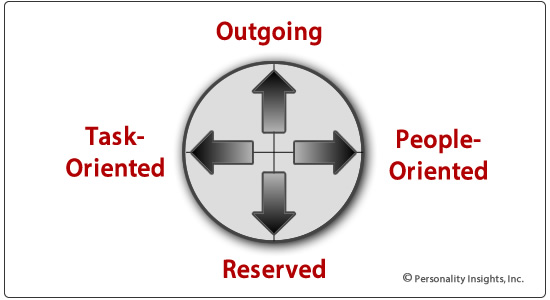Personality Insight
Posted by Kevin Webb
on Mar 06, 2015

Terryanne Daniels (centre), our speaker this past Thursday (March 5th) separates us into our dominant personality traits. (image by Michael Wibbing)
Terryanne stated we have 4 behavioral tendencies to help us characterize people:
- Outgoing
- Reserved
- Task-oriented
- People-oriented
Everyone has some of all 4 of these tendencies at different times and in different situations. However, most people typically have 1 or 2 of these tendencies that seem to fit them well in their everyday behavior. And, on the other hand, 1 or 2 of these tendencies usually do not fit them well, and these tendencies may even seem “foreign” to their approach to life. The balance of these 4 tendencies shapes the way each person “sees” life and those around them. The following diagram shows these 4 basic quadrants as a circle:
Four Major Personality Traits / Tendencies

Thus, 4 basic personality traits emerge from our diagram corresponding to the 4 quadrants of the circle (In clockwise order):
- Outgoing and Task-oriented (upper left quadrant)
- Outgoing and People-oriented (upper right quadrant)
- Reserved and People-oriented (lower right quadrant)
- Reserved and Task-oriented (lower left quadrant)
Next, we will add descriptive terms for each of the four main personality types that emerge in the diagram. The descriptive terms will begin with D, I, S and C.
Describing Each Personality Style (4 Different Types – 4 Different Priorities)
As mentioned before, we will add the descriptive terms to the diagram. Notice the letters D, I, S and C appear in the 4 quadrants of the circle in the diagram below. You will also notice that descriptive terms have been added in each of the 4 corners of the diagram.
D-I-S-C Descriptive Terms

Now we can further describe each of the four main personality styles:
The Dominant “D” type – An outgoing, task-oriented individual will be focused on getting things done, accomplishing tasks, getting to the bottom line as quickly as possible and MAKING IT HAPPEN! (The key insight in developing a relationship with this type person is RESPECT and RESULTS.)
The Inspiring “I” type – An outgoing, people-oriented individual loves to interact, socialize and have fun. This person is focused on what others may think of him or her. (The key insight in developing a relationship with this type person is ADMIRATION and RECOGNITION.)
The Supportive “S” type – A reserved, people-oriented individual will enjoy relationships, helping or supporting other people and working together as a team. (The key insight in developing a relationship with this person is FRIENDLINESS and SINCERE APPRECIATION.)
The Cautious “C” type – A reserved, task-oriented individual will seek value, consistency and quality information. This person focuses on being correct and accurate. (The key insight in developing a relationship with this individual is TRUST and INTEGRITY.)
Summarizing the DISC Traits
To summarize the DISC Model of Human Behavior (in clockwise order):
- D stands for the DOMINANT Type which is OUTGOING and TASK-ORIENTED.
- I stands for the INSPIRING Type which is OUTGOING and PEOPLE-ORIENTED.
- S stands for the SUPPORTIVE Type which is RESERVED and PEOPLE-ORIENTED.
- C stands for the CAUTIOUS Type which is RESERVED and TASK-ORIENTED.
What Is Your PQ (Personality Quotient)?
We spend years in school developing our intelligence to effectively use our mind. Developing our unique personality to effectively use our behavior is just as vital to successful living. Your Intelligence Quotient, or IQ, measures your intelligence. Your Personality Quotient, or PQ, refers to your ability to understand yourself and others for effective communication and teamwork. Studies have shown that technical skill, beginning with intelligence and developed through education and experience, accounts for only 15% of success in the workplace. The other 85% of workplace success comes from people skills! These skills are developed through learning better ways to behave and interact.
The Elevator Test: Which Type Are You?
The elevator doors are about to close on an eager rider who is trying to get on the elevator. Four people are already inside the elevator. One of the people in the crowded box is in a hurry and does not want to wait (outgoing and task-oriented). There is also a bubbly, energetic passenger who holds the door open while greeting the newcomer (outgoing and people-oriented). A third rider is happy either way and smiles while waiting patiently (reserved and people-oriented). The final passenger is concerned as she calculates the weight to see if the elevator can handle another person (reserved and task-oriented).
While not perfectly scientific, this scenario illustrates the Dominant (outgoing / task-oriented) person who is focused on getting somewhere fast; the Inspiring (outgoing / people-oriented) person who is energized by all the interaction; the Supportive (reserved / people-oriented) person who reacts calmly and tries to get along regardless; and the Cautious (reserved / task-oriented) person who wants to make sure the added person doesn’t exceed the weight limit! As you can see, there were four different people who responded to the same event in four very different ways!
Contact Terryanne Daniels at: terryanne@sclondon.ca for more information or to arrange for a Personality Insight Workshop at your company or organization.
